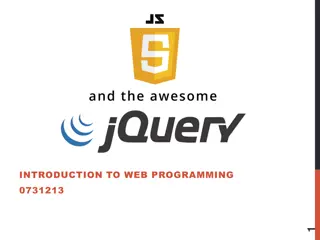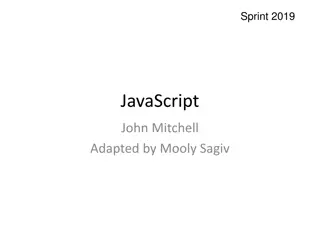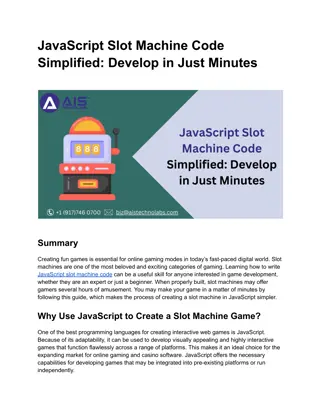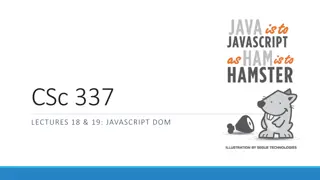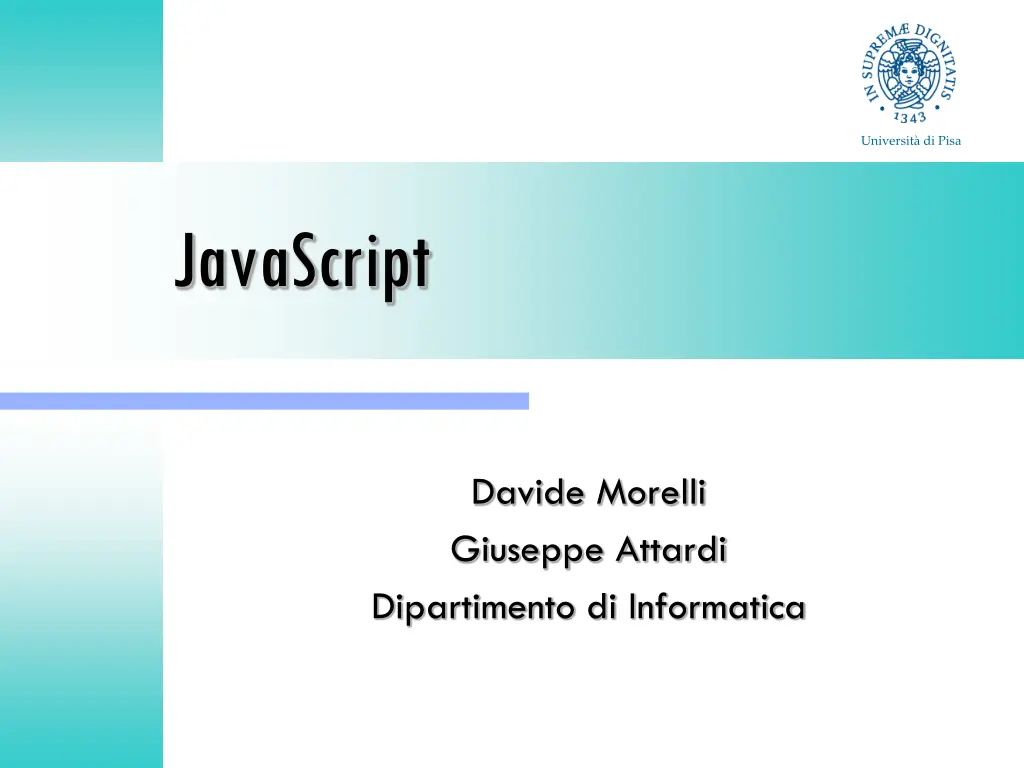
Evolution of JavaScript: From Netscape to WebRTC
Explore the fascinating journey of JavaScript, starting from its humble origins in Netscape to its modern applications like WebRTC. Witness how the language has evolved over the years, embracing new technologies and trends to become a powerful tool for web development.
Download Presentation

Please find below an Image/Link to download the presentation.
The content on the website is provided AS IS for your information and personal use only. It may not be sold, licensed, or shared on other websites without obtaining consent from the author. If you encounter any issues during the download, it is possible that the publisher has removed the file from their server.
You are allowed to download the files provided on this website for personal or commercial use, subject to the condition that they are used lawfully. All files are the property of their respective owners.
The content on the website is provided AS IS for your information and personal use only. It may not be sold, licensed, or shared on other websites without obtaining consent from the author.
E N D
Presentation Transcript
Universit di Pisa JavaScript Davide Morelli Giuseppe Attardi Dipartimento di Informatica
Motivation for JavaScript Netscape, 1995 > 90% browser market share I hacked the JS prototype in ~1 week in May and it showed! Mistakes were frozen early. Rest of year spent embedding in browser -- Brendan Eich, ICFP talk, 2006 Design goals Make it easy to copy/paste snippets of code Tolerate minor errors (missing semicolons) Simplified onclick, onmousedown, etc., event handling Pick a few hard-working, powerful primitives First-class functions, objects everywhere, prototype-based Leave all else out! slide 2
History LiveScript (1995) in Netscape javascript is a misleading name started as a scripting counterpart for java in Netscape battle vs Microsoft ECMAscript current is 7, aka ES2016 coming ES 2017 server side (already present in 1994, now usable) source: wikipedia
History: WEB HTML/CSS JavaScript source: http://blog.bitops.com/assets/GDC2013_HTML5_Games.pdf
History: the platform grew HTML/CSS JavaScript Canvas2D SVG HTML5Audio source: http://blog.bitops.com/assets/GDC2013_HTML5_Games.pdf
History: grew some more HTML/CSS JavaScript Canvas2D SVG HTML5Audio WebGL Typed Array Web Workers Web Sockets Fullscreen source: http://blog.bitops.com/assets/GDC2013_HTML5_Games.pdf
History: lets get crazy HTML/CSS JavaScript Canvas2D SVG HTML5Audio WebGL Typed Array Web Workers Web Sockets Fullscreen WebRTC 2-way low latency audio, video and data Web Audio source: http://blog.bitops.com/assets/GDC2013_HTML5_Games.pdf
History: everything merges together emscripten LLVM to JavaScript compile C/C++ into JS that runs on the web https://github.com/kripken/emscripten/wiki example: http://gnuplot.respawned.com ASM.JS near native JavaScript performance http://asmjs.org source: http://blog.bitops.com/assets/GDC2013_HTML5_Games.pdf
History: server side JavaScript recent trend in SW very effective coupled with nosql example: nodejs + mongodb
Features of the language imperative if, loops, etc.. loosely typed dynamic everything is an object eval functions are objects prototype based
JavaScript in two slides Objects map strings to values (properties): var obj = new Object; obj["prop"] = 42; obj["0"] = hello ; Functions are first-class objects: function fact(n) { return (n == 0) ? 1 : n * fact(n-1); } fact.desc = "Factorial function"; => obj.prop => obj[0]
JS in two slides (2) So methods are function-valued properties: obj.frob = function(n) { this.prop += n; }; obj.frob(6); => obj.prop == 48 Permissiveness throughout. Oops. grob = obj.frob; => var not necessary grob(6); => undefined + 6 == NaN prop = hello ; => reset global prop grob(6); => prop == hello6
Example 1: Browser Events <script type="text/JavaScript"> function onMouseDown(event) { if (event.button==1) { alert("You clicked the right mouse button!") } else { alert("You clicked the left mouse button!") }} </script> <body onmousedown="onMouseDown(event)"> </body> Mouse event causes handler function to be called Other events: onLoad, onMouseMove, onKeyPress, onUnLoad
Document Object Model (DOM) HTML page is structured data DOM provides representation of this hierarchy Examples Properties: document.alinkColor, document.URL, document.forms[ ], document.links[ ], document.anchors[ ], Methods: document.write(document.referrer) These change the content of the page! Also Browser Object Model (BOM) Window, Document, Frames[], History, Location, Navigator (type and version of browser)
Browser and Document Structure W3C standard differs from models supported in existing browsers
Reading Properties with JavaScript Sample script Sample HTML 1. document.getElementById('t1').nodeName 2. document.getElementById('t1').nodeValue 3. document.getElementById('t1').firstChild.nodeName 4. document.getElementById('t1').firstChild.firstChild.nodeName 5. document.getElementById('t1').firstChild.firstChild.nodeValue <ul id="t1"> <li> Item 1 </li> </ul> Example 1 returns "ul" Example 2 returns "null" Example 3 returns "li" Example 4 returns "text" A text node below the "li" which holds the actual text data as its value Example 5 returns " Item 1 " slide 16
Example 2: Page Manipulation Operating on the browser Document Object Model (DOM) createElement(elementName) createTextNode(text) appendChild(newChild) removeChild(node) Example: add a new list item var list = document.getElementById('list1') var newitem = document.createElement('li') var newtext = document.createTextNode(text) list.appendChild(newitem) newitem.appendChild(newtext)
Example 3: Using Cookies Create cookies: document.cookie = "myContents=Quackit JavaScript cookie experiment; expires=Fri, 19 Oct 2007 12:00:00 UTC; path=/"; Reading cookies: document.write(document.cookie); Deleting cookies: document.cookie = "myContents=Quackit JavaScript cookie experiment; expires=Fri, 14 Oct 2005 12:00:00 UTC; path=/";
Types string number booelan Date arrays objects undefined null RegExp, Math, DOM
Logical Operators ==, != ===, !== >, >=, <, <= &&, ||, ! ? :
var dynamic typing types associated with values, not variables var a = 1; console.log(a); a = "ciao"; console.log(a);
Statements blocks scoping: javascript does NOT have block scope var a = 1; { var a = 2; } console.log(a);
Flow Control if switch for for (var i=0; i<arrayname.length; i++) {} for (var itemkey in obj) {} for each (var itemvalue in obj) {} while do
try catch try catch throw finally
Exceptions Throw an expression of any type throw "Error2"; throw 42; throw {toString: function() { return "I'm an object!"; } }; Catch try { } catch (e if e == FirstException") { // do something } catch (e if e == SecondException") { // do something else } catch (e){ // executed if no match above } Reference: http://developer.mozilla.org/en/docs/ Core_JavaScript_1.5_Guide :Exception_Handling_Statements
Functions recursion functions are objects var foo = function(a) { return a + 1; } var a = foo; console.log(a(1)); closures var a = 1; function foo() { return a; } console.log(foo());
More about functions Declarations can appear in function body Local variables, inner functions Parameter passing By value Value model for basic types, reference model for objects Call can supply any number of arguments functionname.length : # of arguments in definition functionname.arguments.length : # args in call Anonymous functions (expressions for functions) (function (x,y) { return x+y }) (2,3); Closures and Curried functions function CurAdd(x){ return function(y) { return x+y } };
Function Examples Anonymous functions in callbacks setTimeout(function() { alert("done"); }, 10000) Curried function function CurriedAdd(x) { return function(y) { return x+y} }; g = CurriedAdd(2); g(3) Variable number of arguments function sumAll() { var total=0; for (var i=0; i< sumAll.arguments.length; i++) total+=sumAll.arguments[i]; return(total); } sumAll(3,5,3,5,3,2,6)
Use of anonymous functions Anonymous functions very useful for callbacks setTimeout(function() { alert("done"); }, 10000) // putting alert("done") in function delays evaluation until call Simulate blocks by function definition and call var u = { a:1, b:2 } var v = { a:3, b:4 } (function (x,y) { var tempA = x.a; var tempB = x.b; // local variables x.a = y.a; x.b = y.b; y.a = tempA; y.b = tempB }) (u,v) // This works because objects are represented by references
Detour: lambda calculus Expressions x + y x + 2*y + z Functions x. (x+y) z. (x + 2*y + z) Application ( x. (x+y)) (3) = 3 + y ( z. (x + 2*y + z))(5) = x + 2*y + 5
Higher-Order Functions Given function f, return function f f f. x. f (f x) How does this work? ( f. x. f (f x)) ( y. y+1) = x. ( y. y+1) (( y. y+1) x) = x. ( y. y+1) (x+1) = x. (x+1)+1 In pure lambda calculus, same result if step 2 is altered.
Full Lexical Closures Lambda calculus Y combinator Y = f. ( x. xx) ( x. f( v. (xx) v) Yfv = f(Yf) v function Y(f) { return function(x) { return x(x); }( function(x) {return f(function(v) { return x(x)(v); }); }); } fact = Y(function(f) { return function(n) { return (n == 0) ? 1 : n * f(n-1); } }); fact(5); => 120
Proof f = function(y) { return function(n) { return (n == 0) ? 1 : n * y(n-1); } Y(f(x))(2) = f(Y(f(x))(2) = (2 == 0) ? 1 : 2 * Y(f(x))(2-1) = 2 * (1 == 0) ? 1 : 1 * Y(f(x))(1-1) = 2 * 1 * (0 == 0) ? 1 : 0 * Y(f(x))(0-1) 2 * 1 * 1 = 2
Same procedure, Lisp syntax Given function f, return function f f (lambda (f) (lambda (x) (f (f x)))) How does this work? ((lambda (f) (lambda (x) (f (f x)))) (lambda (y) (+ y 1)) = (lambda (x) ((lambda (y) (+ y 1)) ((lambda (y) (+ y 1)) x)))) = (lambda (x) ((lambda (y) (+ y 1)) (+ x 1)))) = (lambda (x) (+ (+ x 1) 1))
Same procedure, JavaScript syntax Given function f, return function f f function (f) { return function (x) { return f(f(x)); }; } How does this work? function (x) { return f(f(x)); }; ) (function (y) { return y + 1; }) function (x) { return (function (y) { return y + 1; }) ((function (y) { return y + 1; }) (x)); } function (x) { return (function (y) { return y + 1; }) (x + 1); } function (x) { return x + 1 + 1; }
Basic object features Use a function to construct an object function car(make, model, year) { this.make = make; this.model = model; this.year = year; } Objects have prototypes, can be changed var c = new car( Ford , Taurus ,1988); car.prototype.print = function () { return this.year + + this.make + + this.model;} c.print();
Objects (1) several ways to create objects var a = new Object(); var b = {}; var c = { foo: 1, bar:2 } several ways to add properties b.foo = 1; a['foo'] =1; properties: function are values
Functions as constructors All functions can construct: function Car(make, model) { this.make = make, this.model = model; } myCar = new Car("Porsche , "Boxster"); All functions have a prototype property: Car.prototype.color = "black"; myCar.color; old = new Car("Ford", T"); old.color = "silver"; A constructor function sets a prototype object for newly created objects, from its prototype property => default color => black => black Model T => my override
Classes vs Prototype Class instances are all similar: same attributes from class definition if class changes, old objects will not change Prototype: each object is independent has its own properties properties can be added/deleted if prototype changes, old objects will see new properties
Without Prototype var var Color = function = function (r, g, b) { this.red = = r; this.green = = g; this.blue = = b; this.toCSS = function = function () { return return "rgb(" + this.green + } } green = new = new Color(0, 255, 0); green.toCSS(); each color has its own copy of method toCSS + this.red + + "," + + this.blue + + "," + + + ") ;
With Prototype var var Color = function = function (r, g, b) { this.red = = r; this.green = = g; this.blue = = b; } Color Color.prototype prototype.toCSS = function return return "rgb(" + + + this.green + + + ")"; } green = new = new Color(0, 255, 0); green.toCSS(); = function () { + this.red + + "," + + this.blue + ",
Objects (2) functions as object constructors.. new, this var Person = function(name) { this.name = name; }; var davide = new Person('Davide'); console.log(davide.name); not classes prototype based Person.prototype.getName = function() { return this.name; }; var davide = new Person('Davide'); davide.getName();
Inheritance var Person = function(name) { this.name = name; }; Person.prototype.getName = function() { return this.name; }; var Student = function(name, matricolaID) { this.name = name; this.matricola = matricolaID; } Student.prototype = new Person(); var davide = new Student('Davide', 1); davide.getName();
Inspect > console.dir(davide); Student matricola: 1 name: "Davide" __proto__: Person name: undefined __proto__: Object constructor: function (name) getName: function () __proto__: Object
Object structure objects are associative arrays augmented with prototypes
> red = {"red": 255, "green": 0, "blue": 0} > console.dir(red) Object blue: 0 green: 0 red: 255 __proto__: Object __defineGetter__: function __defineGetter__() __defineSetter__: function __defineSetter__() __lookupGetter__: function __lookupGetter__() __lookupSetter__: function __lookupSetter__() constructor: function Object() hasOwnProperty: function hasOwnProperty() isPrototypeOf: function isPrototypeOf() propertyIsEnumerable: function propertyIsEnumerable() toLocaleString: function toLocaleString() toString: function toString() valueOf: function valueOf() get __proto__: function get __proto__() set __proto__: function set __proto__() > red.hasOwnProperty( blue ) true
get/set along prototype chain var var Color = this.red = this.green = this.blue = Color Color.prototype prototype = green = new = new Color(0, 255, 0); = function function(r, g, b) { = r; = g; = b; } = {bits: 24}; get: up chain until match set: always immediate object shadowing if names match
Modifying vs Setting Prototype how do these differ? Color.prototype.bits = 24; Color.prototype = {bits: 24}; > red = new Color(255, 0, 0) Color > Color.prototype = {bits: 24} Object > green = new Color(0, 255, 0) Color > Color.prototype.space = "RGB" "RGB" > red.bits undefined > green.bits 24 > red.space undefined > green.space "RGB" need to track sharing between object and constructor
Object.create var tim = { name: "Tim Caswell", age: 28, isProgrammer: true, likesJavaScript: true } // Create a child object var jack = Object.create(tim); // Override some properties locally jack.name = "Jack Caswell"; jack.age = 4; // Look up stuff through the prototype chain jack.likesJavaScript;

